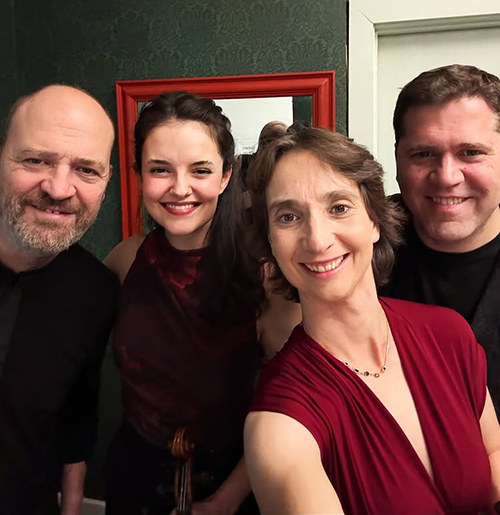by Daniel Hathaway

Cristina Cordero replaced Jonathan Brown at the beginning of the current season, seamlessly joining violinists Abel Tomàs and Vera Martinez Mehner and cellist Arnau Tomàs in the ensemble that was founded at the Escuela Reina Sofia in Madrid in 1997.
Blindfolded, you could almost convince yourself that you were hearing three different string quartets during this sensitively-played program, so masterfully did the Cuarteto adapt its tone and approach to suit the three works on the agenda. It helped that the musicians chose to play the opening Mozart quartet with special bows that they like to use for repertory through Schubert, but the lightness and transparency of their Brahms had less to do with their equipment than with their concept.
With Abel Tomàs playing first violin, the quartet achieved a lean and often playful sound in Mozart’s Quartet in D, Op. 20, engendering smiles with its dotted rhythms and elaborate ornamentation. The wonderfully-phrased Adagio contained an array of colors and the spirited final Allegro was played with a light touch.
Sofia Gubaidulina’s Reflections on the Theme B-A-C-H takes as its inspiration the musical spelling of Bach’s surname (B = B-flat and H = B-natural in German), a series of notes as recognizable as the Dies irae chant — although Gubaidulina makes you wait to hear that phrase intact and harmonized until near the end of the piece. Amid slides into dissonances and punctuated and shimmering notes, the Casals displayed their complete palette of sound. The short work was gripping.
Vera Martinez Mehner, who had traded chairs with Abel Tomàs for the Gubaidulina, remained on first violin for Brahms’ Quartet No. 1, Op. 51, No. 1, and for which the quartet again changed their sound to create full, burnished sonorities. In the Romanze, each smooth line grew out of the one that came before.
Violist Cristina Cordero introduced herself as the ensemble’s new member with a handsome opening solo in the Allegretto, and what followed was Brahms at his most creative as a harmonist. The second section was agreeably folksy and the quartet made a fine transition back to the original material.
The final Allegro was arresting in its dexterity, and the coda was simply amazing. The audience erupted with enthusiastic applause, but Cuarteto Casals refreshingly decided that Brahms was enough said for one evening. They’ll be back.
Published on ClevelandClassical.com November 26, 2024
Click here for a printable copy of this article


